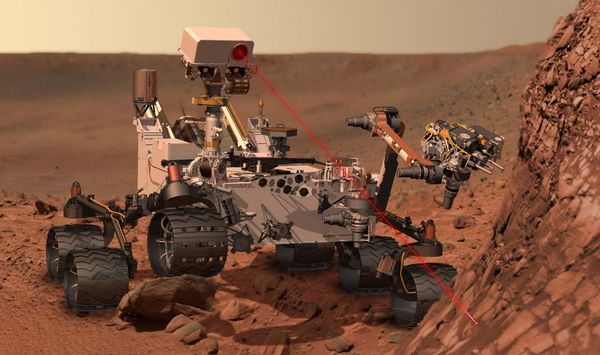Twenty three years after the first module of the International Space Station was launched into space, the station is getting another major upgrade! On January 11th, NASA announced 6 new advanced solar panels will be installed on the ISS starting later this year. These panels are much more efficient than the originals that were installed in the early 2000s, and will enable exciting new experiments on the ISS going forward. But what makes these panels special, and what impact will they have on the ISS and its commercial successors? Let's find out.
Explain Like I'm Five: How do solar panels work?
Let's take a quick look at the fundamentals of semiconductor solar cells. The physics of turning light into electrical energy is done using what are called p-n junctions. Imagine two sides of a circuit with a gap in between. One of the sides is “doped” with either extra electrons (n-type) or extra holes for electrons to go (p-type). On their own, the electrons don’t have enough energy to make the jump across the gap. So at rest, nothing happens.
When you add photons, some of that photon energy is absorbed and gives the electrons enough oomph to jump across the gap. The more electrons that jump across, the more charge is accumulated and whisked away, in this case to be stored in a battery. The catch is that the electrons are picky, and will only get excited by photons that carry a certain amount of energy. And the amount of energy a photon has is related to its wavelength -- shorter wavelengths (bluer light) has more energy. If a photon has too much energy or too little energy, the electron won't jump.
The wavelength range that the circuit is sensitive to depends on the materials. Silicon and Gallium Arsenide work great but there are a bunch of semiconductor materials that will do -- each with their own efficiencies and wavelength bands.
Fun fact: The principles of solar cell technology are the same thing that makes semiconductor cameras work!
These principles are the same thing that makes semiconductor cameras work! Cameras sensitive to visible and short wave infrared light, like Indium Gallium Arsenide (InGaAs) detectors, are based on the same principles and physics—the p-n junction is at the heart of it all. While the goal for a camera is to efficiently convert photons into a measurable voltage to count small differences between cells (i.e. pixels), the goal for a solar array is to efficiently convert photons into a large voltage and use that to charge a battery. It’s the same tech with different applications and different design goals!
The maximum efficiency of a single junction conventional silicon solar cell is somewhere around 34%. As in, 66% of the energy hitting the cell is not converted to harvestable energy even in the ideal case. Modern high-quality conventional solar cells have an efficiency of around 22%.
The efficiency losses come from three primary sources:
- Loss from reflection at the surface. Light gets reflected off of the material before it has a chance to be absorbed.
- Loss from not all photons being converted to energy at the junction. Conventional silicon cells are not sensitive to most of the infrared spectrum, although almost half of the power from the sun falls in that range.
- Loss due to heat. The lost photon energy is converted to heat, which further degrades the efficiency of the cell. The junctions are more efficient when cold.
One way around these efficiency limitations is to use multiple junctions. Consider a junction that can let light pass through it. Photons that are the right wavelength the semiconductor is looking for would be absorbed, but the others would pass on through. Now mix and match multiple layers so as to absorb photons from as many wavelengths as you can. This is the fundamental principle of multi-junction solar cells.
The most common way to do this is use thin film solar cells that are wired up separately outside the cell. This kind of solar cell is commonly based on amorphous silicon with efficiencies in the 9% range but more exotic materials like Germanium and Gallium Arsenide can achieve efficiencies above 30% by this method. Another way to do a multi-junction cell is to have all the layers of the cell “monolithically integrated”, where the layers of a cell are all mechanically and electrically connected. This is harder to do but much more compact. Most multi-junction cells produced to date are triple-junction cells based on Gallium Arsenide compounds.
Fun fact: space station MIR used gallium arsenide solar cells!
Solar cells that you’d install on your house are likely single-junction silicon cells covered in thin glass. This is also the kind of cells that were installed on the space station in the 2000s. The ISS’s new solar panels are Spectrolab Next Triple Junction XTJ Prime, triple-junction Gallium Arsenide cells.
Spectrolab makes panels for Mars rovers and other satellites. They can be considered “run-of-the-mill” solar cells for spacecraft these days.
Rolling out the new upgrades
The current set of solar panels were deployed in December 2000, with more arrays added later in 2006, 2007, and 2009, brought up to the station by the Shuttle. These arrays were built with a 15-year design life, meaning that the oldest set has exceeded its design life by more than 5 years! Basically, the old ones are at the end or have exceeded their design life and new technology is a lot better, like the GaAs triple-junction cells. Installing new arrays provides the International Space Station with enough power to maintain normal operations and ensure adequate power for future opportunities in low-Earth orbit, whether it be for NASA, its international partners, or commercial companies.
The original solar arrays deployed and retracted accordion style on a "blanket." The blanket folded like an accordion for delivery to space and then deployed to its full size once in orbit. Once in orbit, ground controllers sent commands to deploy the blankets to their full size and later to retract them in order to move the solar array truss during the space station's construction. When retracted, each wing folds into a solar array blanket box just 51 centimeters (20 in) high and 4.57 meters (15 ft) in length.
The folding blanket approach was a necessity, but was not perfect. In 2007, the P6 solar array truss was moved from the “top” of the station to the “side” to support a reconfiguration of the station as new modules were being added. The solar arrays were retracted to move the truss. During the redeployment of one of the folding arrays on the STA-20 mission, the blanket on the P6 truss was torn because the array got hung up on a guidewire as it was unfolding. The P6 truss was the first one with these large solar arrays and radiators, installed in December of 2000.
The new arrays are a larger version of the Roll-Out Solar Array (ROSA) that was tested on the station back in 2017, unlike the “folding blanket” method used in the 2000s. The Station will receive six full-size ROSA units in total.
Each ROSA consists of a center wing made of a flexible material containing photovoltaic cells. On either side of the wing is a narrow high strain composite boom that extends the length of the wing to provide support. The booms are like split tubes made of a stiff composite material, flattened and rolled up lengthwise for launch. The array rolls or snaps open without a motor, using stored energy from the structure of the booms that is released as each boom transitions from a coil shape to a straight support arm. And on top of all that, they're still smaller and lighter than traditional arrays this size.

Each ROSA alone will produce more than 20 kW, and there are plans to install 6 of them -- so more than 120 kW at the end -- with a design life of 10 years. The Station's eight original arrays are capable of producing 160 kW in total. The new arrays are smaller but more efficient.
The new roll-up arrays are installed on top of the old arrays, using the same gimbal mounts, and plug in to the same power system to augment current supply. Installation is made possible using a modification kit on top of the existing mast canisters. The ROSA canisters are brought to the ISS in pairs within the trunk of a SpaceX Dragon Capsule. Canadarm retrieves them from Dragon, and installation is done by astronauts over a series of spacewalks.
The solar arrays' goal is obviously to absorb as much energy (as photons) as possible. So the power efficiency is best when the solar panels are perpendicular to the incident light -- this is when the least amount of light would be reflected away and the projected area of the panel facing the incident light is at its largest. Solar panels installed on your home are usually fixed in position, but larger terrestrial solar farms articulate the arrays over the course of the day to maximize the solar power.
The space station rotates the arrays at the attachment point using the Beta Gimbal Assembly (BGA). The solar arrays normally track the Sun, with the "alpha gimbal" used as the primary rotation to follow the Sun as the space station moves around the Earth and the "beta gimbal" used to adjust for the angle of the space station's orbit to the ecliptic, or the angle between the orbital plane of the station and the vector to the sun.
Several different tracking modes are used in nominal operations, ranging from full Sun-tracking, to the drag-reduction mode (night glider and Sun slicer modes), to a drag-maximization mode used to lower the altitude.
Why are there only 6 new arrays? Why not replace all 8 of the old ones?
The 6 new arrays will produce about just as much power as the existing set of 8. The existing set is at the end of its design life but not dead yet and will still be generating power. Use it! If all of the old panels did fail, these 6 new ones would sustain the station.
More panels would be more mass and more cost and more work to install, so more risk too. When more power is collected than is needed, the excess has to be radiated away as heat. Since the 6 new plus 8 old arrays already exceed the station’s requirements, adding even more panels is just a waste. More could probably be added in the future at the remaining two array trusses as the needs of the Station change over time.
Check back Friday for our full episode deep dive into the ISS and its future replacements!







